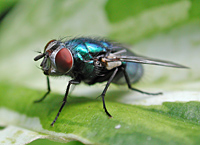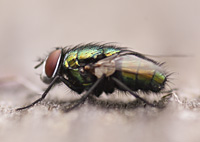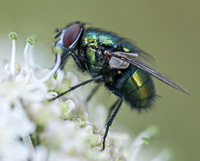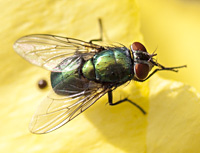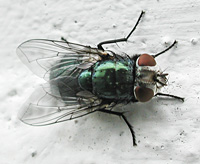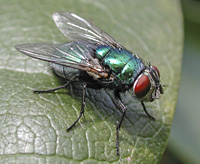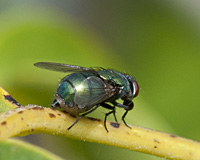[All pictures of garden wildlife on this page are thumbnails. Click on any thumbnail for a large format to be displayed.]

Greenbottle (Lucilia sp.)
| Taxonomy | ||||||
|---|---|---|---|---|---|---|
| Kingdom: | Phylum: | Class: | Order: | Family: | Genus: | Species: |
| Animalia | Arthropoda | Insecta | Diptera | Calliphoridae | Lucilia | Lucilia sp. |
There are many species of green or copper-like flies called Greenbottle in common English. In gardens two species are predominant: Lucilia sericata (Phaenicia sericata) and Lucilia caesar. In the field and just concluding from pictures it is very difficult to tell these two species apart. One of the features distinguishing the two species is the colour of the basicosta. With L. sericata the basicosta is yellowish while with L. caesar it is dark.
To make identification even more complicated, there are more similar species within the genus Lucilia, such us Lucilia bufonivora for instance. It deposits its eggs in the nose of a toad and the reptile is than eaten from within by larvae. Another Greenbottle is Lucilia cuprina. Its larvae have been under special attention of researchers as they excrete an liquid that has strong antibacterial effects. Another remarkable flesh fly is Lucilia sericata. The maggots of this species hav been used to treat dirty wounds. The maggots only eat dead flesh and leave the living flesh intact. On the other hand the maggots cause Fly Strike illness in sheep. There are even more Lucilia species. All are looking like THE Greenbottle, so actually there is no species you may call 'The' Greenbottle.
Moreover, there are also some green house flies, also almost identical to the Greenbottles from the Lucilia genus. These include Neomyia cornicina and Neomyia viridescens. Their maggots do not live in flesh, but in cow dung. You can tell them apart by looking at the angle of the big vein in the wing. Its curve is more rounded than that of the Lucilia species. Neomyia viridescens can be told apart from Neomyia cornicina, for the part just above and between the eyes is green as well. In other species this part is either black or silvry grey. All differences are extremely subtle though. And yes, there also is a green parasitic fly called Gymnocheta viridis. This one however can be told apart from all others, for it has a more elongated shape and it is covered in much longer, thicker and blacker hairs.
On many websites a Greenbottle is simply called Lucilia caesar. In many cases however, it is one of the other green species. This is often due to the fact that in most insect guides and field guides only Lucilia caesar is mentioned. Many people therefore assume it is Lucilia caesar they see. But in most cases they actually see another species and some of which are just as common as Lucilia caesar so a mistake can be easily made.
The bottom photo shows a female Greenbottle fly. Its abdomen is bloated and looking like about to explode. The abdomen is full of eggs so this particular female must be looking for a suitable host to deposit the eggs.

© Copyright 1998-2024 gardensafari.net (Hania Berdys)

 English / engels
English / engels  Dutch / nederlands
Dutch / nederlands